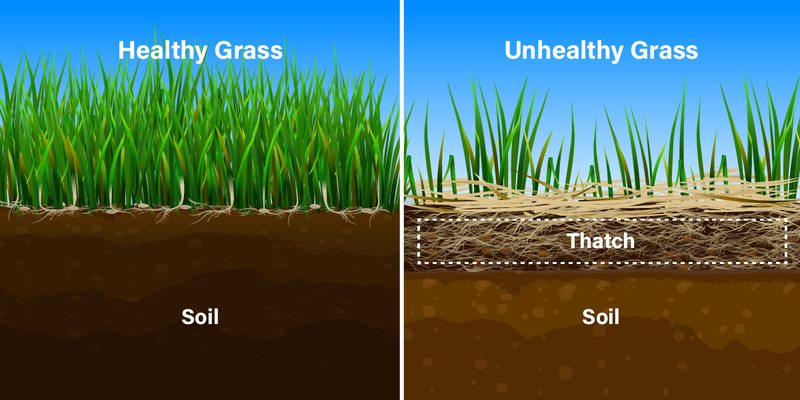By Lauren Pelayo

Image Credit: Biogreenindy
Has thatch taken over your lawn making it impossible for it to grow into its beautiful green lush color? According to Plant for Success in their article Lawn Dethatching: Everything you need to know Thatch is "a mixture of dead and living grass, stems, and roots that form a layer on the top portion of your lawns root system." Thatch is one of those annoying issues that can be caused by many things from acidic soils to the overuse of fertilizer. If this is an issue you’re having we have some tips to keep thatch away and revitalize your lawn; giving off that energy every homeowner is looking for.
First off let me start by saying not all thatch is bad. While a small amount of thatch can help your lawn to retain moisture and buffer extreme temperature fluctuations, too much thatch can leave your lawn looking brown and dull.
In its own way, thatch (that’s no more than ½ thick) can help your lawn conserve moisture and maintain weather fluctuations; that is, if your lawn is already in well balanced condition. Having said that, once the shoots, stems, and roots of the grass become too thick then it’s time to step in. A lawn suffering from an overload of thatch can cause loads of trouble. This can deprive your grass of proper water intake and air circulation creating a good environment for mold as well as attracting pests. Preventative practices can help save you a lot of time and effort in the future, here’s an easy way to keep thatch at bay.
Thatch Raking

Image Credit: KDVR
Thatch raking is one effective way to keep the health of your lawn in a balanced state. Not only is this process extremely affordable but it also allows you to spend more quality time outdoors and get a light exercise in (depending on the size of your lawn). The best time to do some Thatch raking is in the early spring when the soil is moist and loose, preferably after the first mow of the season. Thatch raking is typically recommended for smaller lawns as it does entail the use of a deep rake and it must be pushed in deep to properly remove thatched areas. According to Pepper Home Garden in their article “how to dethatch your lawn,” “If your lawn is larger than 1500 square feet use a power rake, vertical mower or tow-behind dethatcher.”
Thatching Agents

If the thatch in your lawn has been left for sometime then consider investing in some back up material. Once your grass is being noticeably choked by the overwhelming presence of thatch layers then Thatch Relief, a biological thatch reduction formula, may be your new best friend. This is "a natural product for the accelerated decomposition of excessive thatch in turf grass. "It's used to reduce the need for expensive mechanical de-thatching (raking, slicing, aerating)."The best times to apply Thatch Relief are in the spring and fall. Paired with Oasys Ultra gives your lawn the boost of hydration it's been needing. It acts as "a wetting agent, provides a Liquid Aeration program to eliminate the need for expensive core aerification of lawns."

Image Credit: soandmo
Thatch is your lawns way of telling you it's experiencing an imbalance. It's happening because the soil can't break down the organic matter quick enough to keep up with the new matter being introduced. This break down process is natural for a healthy grass organism and when the balance is correct it can and will maintain the proper cycle without getting overwhelmed. According to Plant for Success in their article Lawn Dethatching: Everything you need to know some causes for thatch are "synthetic fertilizers, poor aeration and drainage, too much watering, too little watering, and poor management of disease and stress."
Exhausting synthetic fertilizers

Image Credit: BHG
When making the decision to reach for synthetic fertilizers it's important to remember that anything artificial will have negative effects on the natural balance of your land. They act as a temporary fix but leave lasting impacts; especially those larger turf surfaces like golf courses. These businesses have a reputation for exhausting these chemicals in an attempt to maintain that green look. Synthetic chemicals strip grass of their soil structure and decrease (or eliminate when overused) the microbial balance that allows your lawn to properly break down thatch.
Aeration & Drainage

Image Credit: tipsfromashton
When it comes to aeration or drainage, I like to think of watering a plant in a pot. If there's no drainage after a good watering, then it sits in the soil drowning the plant and creating a ripe environment for mold. The same is to be said about grass as it requires good circulation of air allowing it to break down thatch properly.
Watering in balance

Image Credit: organolawn
We've all seen the effects of lack of watering as well of overwatering. Too much of either will cause thatch to overtake your turf. Keep to a watering schedule and adjust it according to your climate. If you're in a zone that sees plenty of rainfall, then it would be wise to water less often so you don't drown your turf. The opposite should be said for dryer zones, if you see your grass is baking from the heat it would be good to add an evening time watering session to keep thatch at bay.
Stress & Diseases

Image Credit: greencast.ca
Those yellowish patchy spots on your lawn aren't extraterrestrial visits rather their lawn diseases. Tackling these issues requires a holistic approach; if one part of your lawn is experiencing disease then the entire lawn will be working overtime to correct it. Manage diseases early and try to find the root of the issue rather than turning to "quick fixes," like synthetic fertilizers or heavy pesticides/insecticides. Every issue is unique and should be treated accordingly as every zone experiences different weather fluctuations, insects and biology traits that require their own treatment types.
The reality of being a gardener on any scale is that it's a constant learning experience. I know how irritating it can be when you've solved one issue and are then met with four more but continue being curious dear reader. Let the fact that nature has a way of keeping the balance be your North Star. And remember that when practices are either over or underused that balance is interrupted. It's never too late to nurse your land back to health and with these tips you'll have a strong chance of experiencing a well-balanced thriving turf.

